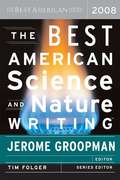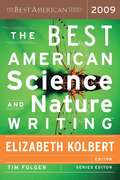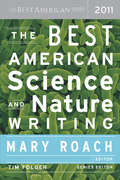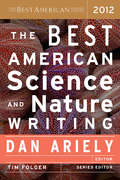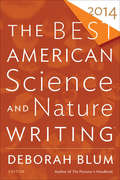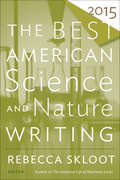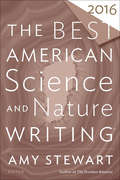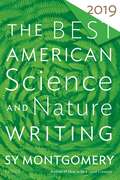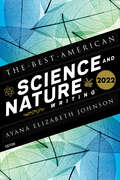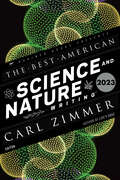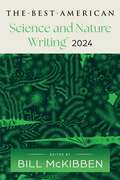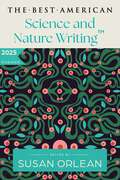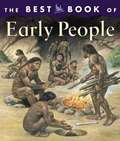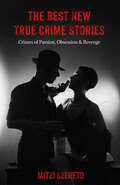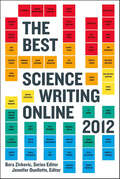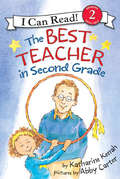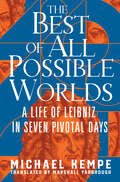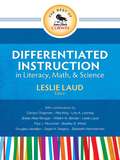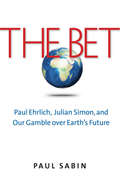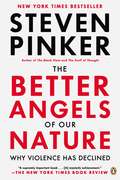- Table View
- List View
The Best American Science and Nature Writing 2008
by Jerome GroopmanBest-selling author and staff writer for The New Yorker Jerome Groopman, M.D., edits this year's volume of the finest science and nature writing. From prize-winning favorites, this is a "wonderful series where students find plenty of inspiration"
The Best American Science and Nature Writing 2009
by Elizabeth KolbertElizabeth Kolbert, one of today's leading environmental journalists, edits this year's volume of the finest science and nature writing.
The Best American Science and Nature Writing 2011: The Best American Series (The Best American Series)
by Mary RoachThe New York Times–bestselling author of Packing for Mars presents fascinating essays by Jonathan Lethem, Jaron Lanier, Malcom Gladwell and others.Good science writing, as Mary Roach explains in her introduction, is a cure for ignorance and fallacy. But great science writing adds honey—in the form of engaging characters, stories, and wit—to make the medicine go down. This anthology reveals the essential humanity in our endless quest for knowledge and understanding.From a study of avian mating habits with unintended political implications to a sober exploration of the panic surrounding artificial intelligence, The Best Science and Nature Writing 2011 offers food for thought in a variety of flavors.The Best Science and Nature Writing 2011 includes entries by Deborah Blum, Burkhard Bilger, Ian Frazier, David H. Freedman, Atul Gawande, Stephen Hawking, Christopher Ketcham, Jill Sisson Quinn, Oliver Sachs, and others.
The Best American Science and Nature Writing 2012 (The Best American Series)
by Sy Montgomery Elizabeth Kolbert Jerome E. Groopman Deborah Blum Rivka Galchen John Seabrook Bijal P. Trivedi Mark McClusky&“Top-notch science writing covering everything from the 1,000 species in the human gut to efforts to reverse-evolve a chicken into a dinosaur.&” —Kirkus Reviews With contributions from bestselling and award-winning writers including Jerome Groopman and Elizabeth Kolbert, this volume delves into such topics as the 2008 &“Black Friday&” stampede at a Long Island Walmart; an annual humans-vs.-AI competition; octopus intelligence; lab-grown meat; marauder ants; the brains of teenagers; and the Neanderthal genome. Lively and accessible, this is &“a showcase for clean, plain-English science and nature writing and a treat for readers&” (Kirkus Reviews). &“This strong collection invites awe, begets wonder, and stimulates contemplation.&” —Publishers Weekly &“There is so much we don&’t know, which leads us to make so many irrational decisions that we need scientists and science writers to share their inquiries and discoveries in welcoming and lucid prose. Stellar examples of just this sort of cogent and compelling writing sustains this invaluable and exciting series.&” —Booklist Contributors include: Brendan Buhler · Virginia Hughes • Jerome Groopman • Carl Zimmer • Thomas Hayden • Michael Behar • Bijal P. Trivedi • Sy Montgomery • Mark W. Moffett • Deborah Blum • Elizabeth Kolbert • Michael Roberts • Thomas Goetz • Jason Daley • David Dobbs • David Eagleman • John Seabrook • David Kirby • Robert Kunzig • Michael Specter • Mark McClusky • Rivka Galchen • Joshua Davis • Brian Christian
The Best American Science and Nature Writing 2014 (The Best American Series)
by Barbara Kingsolver Carl Zimmer Elizabeth Kolbert Rebecca Solnit Nicholas Carr Seth Mnookin Fred Pearce E. O. Wilson&“A stimulating compendium&” on topics from antibiotics to animals, featuring Rebecca Solnit, E.O. Wilson, Nicholas Carr, Elizabeth Kolbert, and many more (Kirkus Reviews). &“A consistently strong series . . . Making connections between seemingly unrelated topics can help expand thinking, as seen in the effects of automated navigation on both airplane pilot error and Inuit hunting accidents that Nicholas Carr explores in &‘The Great Forgetting.&’ Sarah Stewart Johnson makes a similar connection between the loss of a 1912 Antarctic expedition and the explosion of the space shuttle Challenger in &‘O-Rings.&’ . . . Essays like Virginia Hughes&’s &‘23 and You&’ investigates the effects of availability of individual genetic information on human interactions, while pieces like Maryn McKenna&’s &‘Imagining the Post-Antibiotics Future&’ and Kate Sheppard&’s &‘Under Water&’ remind us of unpleasant futures which we have in large part created ourselves. But Barbara Kingsolver&’s &‘Where it Begins,&’ a lyrical musing on connectedness, or Wilson&’s optimistic, bug-loving &‘The Rebirth of Gorongosa,&’ reveal that among the strange, shocking, or depressing, there is still unadulterated joy to be found.&” —Publishers Weekly &“Undeniably exquisite . . . meditations that reveal not only how science actually happens but also who or what propels its immutable humanity.&” —Maria Popova, Brain Pickings Contributors include: Katherine Bagley • Nicholas Carr • David Dobbs • Pippa Goldschmidt • Amy Harmon • Robin Marantz Henig • Virginia Hughes • Ferris Jabr • Sarah Stewart Johnson • Barbara J. King • Barbara Kingsolver • Maggie Koerth-Baker • Elizabeth Kolbert • Joshua Lang • Maryn McKenna • Seth Mnookin • Justin Nobel • Fred Pearce • Corey S. Powell • Roy Scranton • Kate Sheppard • Bill Sherwonit • Rebecca Solnit • David Treuer • E.O. Wilson • Carl Zimmer
The Best American Science and Nature Writing 2015 (The Best American Series)
by Rebecca SklootThis anthology of essays and articles explores topics ranging from untouched wilderness to scientific ethics—and the nature of curiosity itself. Scientists and writers are both driven by a dogged curiosity, immersing themselves in detailed observations that, over time, uncover larger stories. As Rebecca Skloot says in her introduction, all the stories in this collection are &“written by and about people who take the time, and often a substantial amount of risk, to follow curiosity where it may lead, so we can all learn about it.&”The Best American Science and Nature Writing 2015 includes work from both award-winning writers and up-and-coming voices in the field. From Brooke Jarvis on deep-ocean mining to Elizabeth Kolbert on New Zealand&’s unconventional conservation strategies, this is a group that celebrates the growing diversity in science and nature writing alike. Altogether, the writers honored in this volume challenge us to consider the strains facing our planet and its many species, while never losing sight of the wonders we&’re working to preserve for generations to come. This anthology includes essays and articles by Sheri Fink, Atul Gawande, Leslie Jamison, Sam Kean, Seth Mnookin, Matthew Power, Michael Specter and others.
The Best American Science and Nature Writing 2016 (The Best American Series)
by Amy Stewart, Tim FolgerThis anthology collects some of the year&’s best science and nature writing—from climate change to killer beetles, an exposé of nail salons, and more. As guest editor Amy Stewart says in her introduction, &“science writers get into the game with all kinds of noble, high-minded ambitions. We want to educate. To enlighten…But at the end of the day, we&’re all writers. We&’re just like novelists, memoirists, and poets. We&’re entertainers.&” The writers in this anthology pull off that wonderful feat of turning hard research into page-turning narrative. From a Pulitzer Prize–winning essay on the earthquake that could decimate the Pacific Northwest to the astonishing work of investigative journalism that transformed the nail salon industry, this is a collection of hard-hitting and beautifully composed writing on the wonders, dangers, and oddities of scientific innovation and our natural world. The Best American Science and Nature Writing 2016 includes Kathryn Schulz, Sarah Maslin Nir, Charles C. Mann, Oliver Sacks, Elizabeth Kolbert, Gretel Ehrlich, and others.
The Best American Science and Nature Writing 2019 (The Best American Series ®)
by Sy Montgomery Jaime GreenA NATIONAL BESTSELLER Sy Montgomery, New York Times best-selling author and recipient of numerous awards, edits this year’s volume of the finest science and nature writing. “Science is important because this is how we seek to discover the truth about the world. And this is what makes excellent science and nature writing essential,” observes New York Times best-selling author Sy Montgomery. “Science and nature writing are how we share the truth about the universe with the people of the world.” And collected here are truths about nearly every corner of the universe. From meditations on extinction, to the search for alien life, to the prejudice that infects our medical system, the pieces in this year’s Best American Science and Nature Writing seek to bring to the people stories of some of the most pressing issues facing our planet, as well as moments of wonder reflecting the immense beauty our natural world offers.
The Best American Science and Nature Writing 2022 (Best American)
by Jaime Green Ayana Elizabeth JohnsonA collection of the best science and nature articles written in 2021, selected by guest editor renowned marine biologist Dr. Ayana Elizabeth Johnson and series editor Jaime Green. Dr. Ayana Elizabeth Johnson, renowned marine biologist and co-founder of the All We Can Save climate initiative, compiles the best science and nature writing of the year.
The Best American Science and Nature Writing 2023 (Best American)
by Carl Zimmer Jaime GreenThe Best American Science and Nature Writing 2023 has descriptive copy which is not yet available from the Publisher.
The Best American Science and Nature Writing 2024
by Bill McKibben Jaime GreenAward-winning environmentalist, author, and journalist Bill McKibben selects twenty science and nature essays that represent the best examples of the form published in the previous year.“This was the most anomalous year (so far) in human history,” guest editor Bill McKibben writes, “the year in which the relationship between people and planet showed its most dramatic signs yet of unraveling.” The selections in The Best American Science and Nature Writing 2024 reveal a trying year for our planet—from the Lahaina wildfire tragedy to the lush Amazon jungle slowly turning to savanna—while also celebrating the earth’s beautiful and mysterious ways—from the largest beaver dam on earth to the heroic innovation to prevent birds from crashing into Chicago’s expanse of glass buildings. These essays offer solace in trying times, showing a way for a better future. They are, as McKibben says, “a reminder that this world is still a lovely and deep place, well worth the fighting for.”The Best American Science and Nature Writing 2024 includes IAN FRAZIER • AMANDA GEFTER • DOUGLAS FOX • SARAH KAPLAN • BEN GOLDFARB • RAYMOND ZHONG • ALEX CUADROS • AND OTHERS
The Best American Science and Nature Writing 2025
by Susan Orlean Jaime Green“The best science and nature writing—which these stories represent—reminds us of the wide world and our connection to it, and the multitude of ways we make our place in it,” writes Susan Orlean in her introduction. This year’s collection masterfully guides us through exotic locations and groundbreaking research, leading us to consider complex and utterly fascinating questions about the world. How does it feel to camp in one of the hottest places on Earth? Is the ability to recognize and remember faces a sign of intelligence? What does it mean for a species to be wild or invasive—are city pigeons and rats less deserving than the coyotes that recently wandered down from Westchester? Encompassing the strangeness and, at times, severity of our world, these stories are urgent, vital, and ultimately inspiring. As Orlean eloquently observes, “Science keeps unlocking mysteries, revealing secrets, helping us heal. And as imperiled as nature seems, it remains amply, gloriously gorgeous: The world is still full of beauty.”THE BEST AMERICAN SCIENCE AND NATURE WRITING 2025 INCLUDES: FERRIS JABR • EMILY RABOTEAU • RIVKA GALCHEN • BEN GOLDFARB • DAVID NAIMON • TOM MCALLISTER • KATIE ENGELHART • AND OTHERS
The Best Book of Early People
by Mike White Margaret HynesChildren are very curious about who their prehistoric ancestors were, how they lived, and what they may have looked like, and The Best Book of Early People by Margaret Hynes and Mike White is just the source to satisfy emerging anthropologists. Children will learn how early families survived, hunted, gathered into primitive settlements, began to use tools, and invented farming techniques. Step-by-step illustrations and captions explore ancient villages and the work of the scientists who find and catalog their discoveries.
The Best New True Crime Stories: Serial Killers (The\best New True Crime Stories Ser.)
by Mitzi SzeretoObsession, Unrequited Love, Jealousy, Revenge, and Violence Collide in this Page-Turning Anthology#1 New Release in Forensic Science Law and Hoaxes & DeceptionsCrimes of passion are both eerie and strangely tantalizing. How can someone you hold dear become someone you fear? This riveting anthology explores the question through some of the most compelling true crime accounts and stories of obsession and vengeance.Crimes fueled by emotions. Love, passion, obsession, jealousy, and betrayal. When it comes to the emotions, people can react in strange and unexpected ways. Whether it’s a heart hurt by unrequited love, or a lover so passionate they’ll stop at nothing to get their way—even the most mild-mannered soul can suddenly flip, becoming a vengeful spirit with dark intentions. From the ancient Greek myth of Jason and Medea to Shakespeare’s Othello, themes dealing with deeply felt emotions have persisted. But unlike mythology or fiction, The Best New True Crime Stories: Crimes of Passion, Obsession & Revenge contains stories from real life.A special selection of stories written exclusively for this book. The Best New True Crime Stories: Crimes of Passion, Obsession & Revenge includes stories from around the world and from different times. As with all titles in the popular The Best New True Crime Stories series, this volume contains original nonfiction accounts penned by writers from across the literary spectrum. Dive into these twisted true tales of passion and unrequited love turned violent. Examine why some have fully embraced their dark side, resorting to crime to achieve their own special brand of satisfaction and retribution.If you enjoyed Mitzi's last book in her series, The Best New True Crime Stories: Well-Mannered Crooks, Rogues & Criminals, and books like You Love Me, and The Big Book of Serial Killers Volume 2, then you’ll love The Best New True Crime Stories: Crimes of Passion, Obsession & Revenge.
The Best Science Writing Online 2012
by Bora Zivkovic and Jennifer OuelletteShowcasing more than fifty of the most provocative, original, and significant online essays from 2011, The Best Science Writing Online 2012 will change the way we think about science— from fluids to fungi, poisons to pirates. Featuring noted authors and journalists as well as the brightest up-and-comers writing today, this collection provides a comprehensive look at the fascinating, innovative, and trailblazing scientific achievements and breakthroughs of 2011, along with elegant and thought-provoking new takes on favorite topics. This is the sixth anthology of online essays edited by Bora Zivkovic, the blogs editor at Scientific American, and with each new edition, Zivkovic expands his fan base and creates a surge of excitement about upcoming compilations. Now everyone's favorite collection will reach new horizons and even more readers. Guest-edited and with an introduction by the renowned science author and blogger Jennifer Ouellette, The Best Science Writing Online 2012 marries cutting-edge science with dynamic writing that will inspire us all.
The Best Teacher in Second Grade (I Can Read Level 2)
by Katharine KenahThis heartfelt story shows the difference a good teacher can make in a student’s life!Luna has the best teacher in second grade. Mr. Hopper loves the midnight sky almost as much as Luna does, but the rest of the class isn’t on the same page. They won’t listen to her ideas for the Family Night program—until something goes unexpectedly wrong! With a nudge from Mr. Hopper, Luna shares her plan, which just might save the show.From the team that wrote and illustrated The Best Seat in Second Grade and The Best Chef in Second Grade, this appealing story will appeal to all second graders, as well as their parents, caregivers, and, especially, teachers!This Level Two I Can Read is geared toward kids who read on their own but still need a little help. Whether shared at home or in a classroom, the engaging stories, longer sentences, and language play of Level Two books are proven to help kids take their next steps toward reading success.
The Best of All Possible Worlds: A Life of Leibniz in Seven Pivotal Days
by Michael KempeA biography of the polymath Gottfried Wilhelm Leibniz told through seven critical days spanning his life and revealing his contributions to our modern world. Gottfried Wilhelm Leibniz (1646–1716) was the Benjamin Franklin of Europe, a “universal genius” who ranged across many fields and made breakthroughs in most of them. Leibniz invented calculus (independently from Isaac Newton), conceptualized the modern computer, and developed the famous thesis that the existing world is the best that God could have created. In The Best of All Possible Worlds, historian and Leibniz expert Michael Kempe takes us on a journey into the mind and inventions of a man whose contributions are perhaps without parallel in human history. Structured around seven crucial days in Leibniz’s life, Kempe’s account allows us to observe him in the act of thinking and creating, and gives us a deeper understanding of his broad-reaching intellectual endeavors. On October 29, 1675, we find him in Paris, diligently working from his bed amid a sea of notes, and committing the integral symbol—the basis of his calculus—to paper. On April 17, 1703, Leibniz is in Berlin, writing a letter reporting that a Jesuit priest living in China has discovered how to use Leibniz’s binary number system to decipher an ancient Chinese system of writing. One day in August 1714, Leibniz enjoys a Viennese coffee while drawing new connections among ontology and biology and mathematics. The Best of All Possible Worlds transports us to an age defined by rational optimism and a belief in progress, and will endure as one of the few authoritative accounts of Leibniz’s life available in English.
The Best of Corwin: Differentiated Instruction in Literacy, Math, and Science
by Leslie E. LaudContent-specific DI guidance from the best minds in education In this collection, current research on the most effective differentiation practices for differentiating instruction in literacy, mathematics, and scienceis brought alive through the many strategies and examples. Topics covered include: Reading and writing: A comprehensive array of models for differentiating reading instruction; gradual release of responsibility to accelerate progress; and multi-tiered writing instruction Mathematics: Support for both low- and high-achieving students, including interventions and challenges, and the implementation of RTI in math instruction Science: Models and methods for increasing student achievement through differentiated science inquiry
The Bet
by Paul SabinIn 1980, the iconoclastic economist Julian Simon challenged celebrity biologist Paul Ehrlich to a bet. Their wager on the future prices of five metals captured the publics imagination as a test of coming prosperity or doom. Ehrlich, author of the landmark book "The Population Bomb, " predicted that rising populations would cause overconsumption, resource scarcity, and famine--with apocalyptic consequences for humanity. Simon optimistically countered that human welfare would flourish thanks to flexible markets, technological change, and our collective ingenuity. Simon and Ehrlichs debate reflected a deepening national conflict over the future of the planet. "The Bet" weaves the two mens lives and ideas together with the eras partisan political clashes over the environment and the role of government. In a lively narrative leading from the dawning environmentalism of the 1960s through the pivotal presidential contest between Jimmy Carter and Ronald Reagan and on into the 1990s, Paul Sabin shows how the fight between Ehrlich and Simon--between environmental fears and free-market confidence--helped create the gulf separating environmentalists and their critics today. Drawing insights from both sides, Sabin argues for using social values, rather than economic or biological absolutes, to guide societys crucial choices relating to climate change, the planets health, and our own.
The Bethe Wavefunction
by Michel GaudinMichel Gaudin's book La fonction d'onde de Bethe is a uniquely influential masterpiece on exactly solvable models of quantum mechanics and statistical physics. Available in English for the first time, this translation brings his classic work to a new generation of graduate students and researchers in physics. It presents a mixture of mathematics interspersed with powerful physical intuition, retaining the author's unmistakably honest tone. The book begins with the Heisenberg spin chain, starting from the coordinate Bethe Ansatz and culminating in a discussion of its thermodynamic properties. Delta-interacting bosons (the Lieb-Liniger model) are then explored, and extended to exactly solvable models associated to a reflection group. After discussing the continuum limit of spin chains, the book covers six- and eight-vertex models in extensive detail, from their lattice definition to their thermodynamics. Later chapters examine advanced topics such as multi-component delta-interacting systems, Gaudin magnets and the Toda chain.
The Better Angels of Our Nature: Why Violence Has Declined (Playaway Adult Nonfiction Ser.)
by Steven PinkerFaced with the ceaseless stream of news about war, crime, and terrorism, one could easily think we live in the most violent age ever seen. Yet as New York Times bestselling author Steven Pinker shows in this startling and engaging new work, just the opposite is true: violence has been diminishing for millennia and we may be living in the most peaceful time in our species's existence. For most of history, war, slavery, infanticide, child abuse, assassinations, pogroms, gruesome punishments, deadly quarrels, and genocide were ordinary features of life. But today, Pinker shows (with the help of more than a hundred graphs and maps) all these forms of violence have dwindled and are widely condemned. How has this happened?<P><P> This groundbreaking book continues Pinker's exploration of the essence of human nature, mixing psychology and history to provide a remarkable picture of an increasingly nonviolent world. The key, he explains, is to understand our intrinsic motives- the inner demons that incline us toward violence and the better angels that steer us away-and how changing circumstances have allowed our better angels to prevail. Exploding fatalist myths about humankind's inherent violence and the curse of modernity, this ambitious and provocative book is sure to be hotly debated in living rooms and the Pentagon alike, and will challenge and change the way we think about our society.<P> Chosen for Mark Zuckerberg's "A Year of Books" <P><b>A New York Times Bestseller</b>
The Better Half: On the Genetic Superiority of Women
by Shäron MoalemA Guardian Book of the WeekLonglisted for the PEN / E. O. Wilson Literary Science Writing AwardAn award-winning physician and scientist makes the game-changing case that genetic females are stronger than males at every stage of lifeHere are some facts: Women live longer than men. They have stronger immune systems. They're better at fighting cancer and surviving famine, and even see the world in a wider variety of colors. They are simply stronger than men at every stage of life. Why is this? And why are we taught the opposite?To find out, Dr. Sharon Moalem drew on his own medical experiences - treating premature babies in the neonatal intensive care unit; recruiting the elderly for neurogenetic studies; tending to HIV-positive orphans in Thailand - and tried to understand why in every instance men were consistently less likely to thrive. The answer, he discovered, lies in our genetics: two X chromosomes offer a powerful survival advantage.With clear, captivating prose that weaves together eye-opening research, case studies, diverse examples ranging from the behavior of honeybees to American pioneers, as well as experiences from his personal life and his own patients, Moalem explains why genetic females triumph over males when it comes to resiliency, intellect, stamina, immunity and much more. He also calls for a reconsideration of our male-centric, one-size-fits-all view of medical studies and even how we prescribe medications - a view that still sees women through the lens of men.Revolutionary and yet utterly convincing, The Better Half will make you see humanity and the survival of our species anew.
The Better to Eat You With: Fear in the Animal World
by Joel BergerCan naive animals avoid extinction when they encounter reintroduced carnivores? To what extent is fear culturally transmitted? And how can a better understanding of current predator-prey behavior help demystify past extinctions and inform future conservation? "The Better to Eat You With" is the chronicle of Berger's search for answers. From Yellowstone's elk and wolves to rhinos living with African lions and moose coexisting with tigers and bears in Asia, Berger tracks cultures of fear in animals across continents and climates, engaging readers with a stimulating combination of natural history, personal experience, and conservation.
The Bible Cure for High Cholesterol
by Don ColbertLower your cholesterol, and feel better naturally. Don't let a diagnosis of high cholesterol scare you. This easy-to-understand book uncovers a dynamically unique strategy for gaining control and living in vibrant, divine health--naturally. Reclaim God's very best for you, and get ready to win! You will: identify cholesterol-busting foods that can dramatically reduce your cholesterol levels; learn how powerful supplements can restore your health; discover what foods sabotage your cholesterol health. You want to be healthy. God wants you to be healthy. At last, here's a source of information that will help you live in health--body, mind and spirit.
